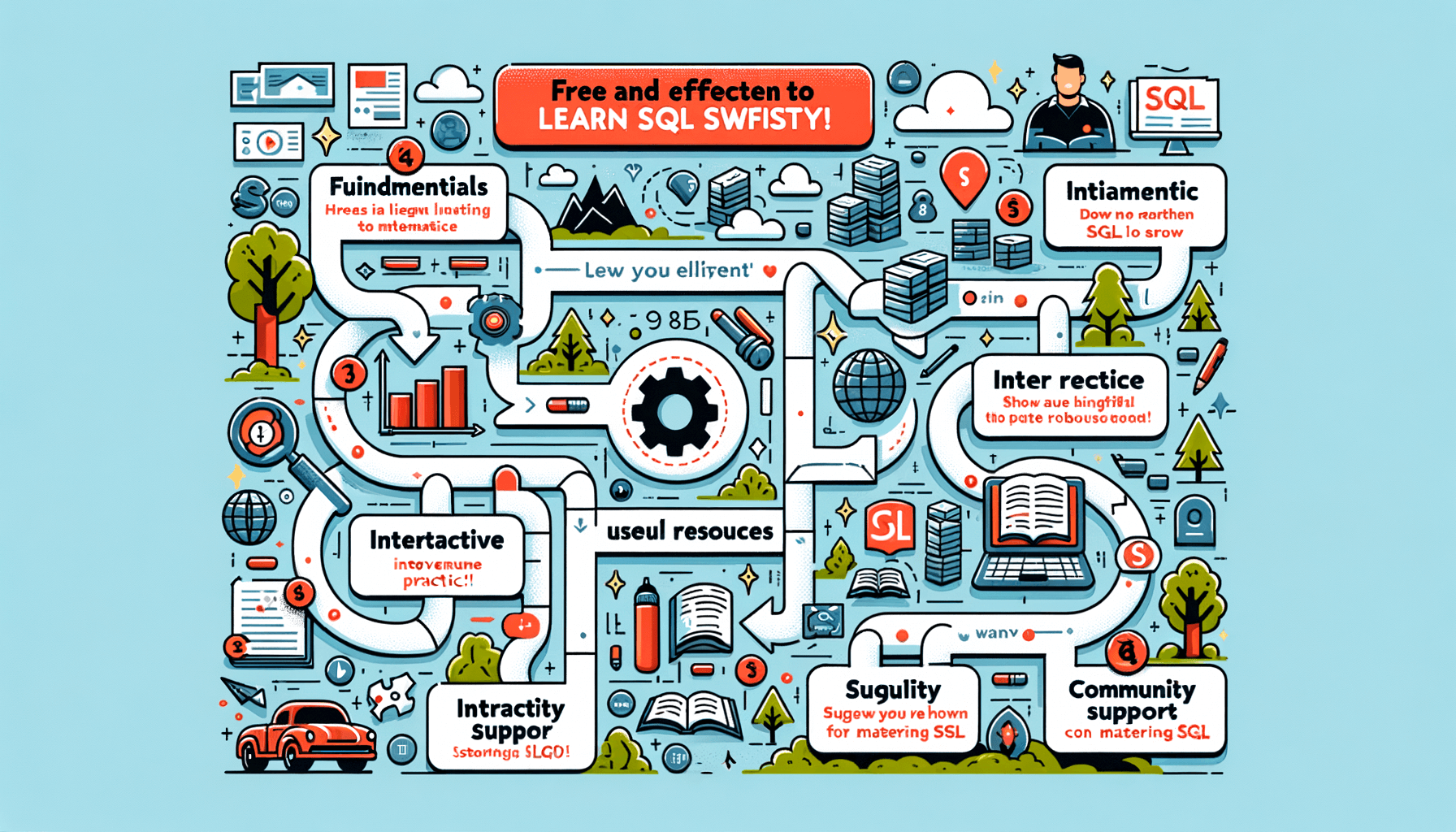A big variety of articles and resources

Learn SQL from Experts: Insider Tips and Techniques for Mastery
 Sia Author and Instructor
Learn SQL
Sia Author and Instructor
Learn SQL
8 minute read
Decoding SQL Syntax: Essential Foundations
Understanding Basic Commands
SQL syntax may seem daunting at first, especially if you're accustomed to other programming languages. Mastering the basic commands such as SELECT, INSERT, UPDATE, and DELETE is crucial. These commands allow you to perform essential operations on data stored in a database.
Navigating Complex Queries
As you delve deeper into SQL, you'll encounter more complex queries. Learning how to effectively combine conditions with AND, OR, and NOT can significantly enhance your query capabilities. Utilizing joins to merge data from multiple tables is also a key skill in handling complex queries.
Best Practices for Syntax Efficiency
Efficient SQL syntax is not only about knowing what to write but also how to write it succinctly. Use of aliases, proper formatting, and avoiding redundant code can greatly improve the readability and performance of your SQL queries. Here are some tips to keep your SQL code clean and efficient:
- Use aliases to shorten your queries.
- Format your SQL code for better readability.
- Avoid redundant or unnecessary conditions in your queries.
Mastering SQL Joins and Relationships
Types of Joins Explained
SQL joins are fundamental for combining rows from two or more tables based on a related column between them. Understanding the different types of joins—such as INNER JOIN, LEFT JOIN, RIGHT JOIN, and FULL OUTER JOIN—is crucial for effective data manipulation. Each join type serves a unique purpose depending on the data retrieval needs.
Optimizing Queries with Joins
To enhance the performance of SQL queries involving joins, it's essential to consider factors like indexing and the size of the datasets. Proper use of joins can significantly reduce query time and resource consumption. Strategies such as filtering data before joining tables or using indexed columns in the join condition can lead to more efficient queries.
Real-World Examples and Applications
Joins are not just theoretical; they are extensively used in real-world applications. From generating comprehensive reports to real-time data analysis, the ability to master SQL joins is invaluable. Here are a few examples:
- Combining customer and order data to analyze purchasing patterns.
- Linking product information to inventory levels for supply chain management.
- Merging employee and department data for HR analytics.
Joins are a powerful tool in SQL that, when mastered, open up a myriad of possibilities for data analysis and manipulation.
Advanced SQL Functions for Data Manipulation
Utilizing Aggregate Functions
Aggregate functions are pivotal in SQL for summarizing or analyzing data. Functions like AVG, SUM, MAX, and MIN allow you to perform calculations across a set of values, returning a single value. Mastering these functions is essential for effective data analysis. They are particularly useful in generating reports or gaining insights from large datasets.
Subqueries and Nested Logic
Subqueries and nested logic enhance the power and flexibility of SQL queries. A subquery is a query within another SQL query, which can be used for complex data filtering, manipulation, or comparison. Nested logic, involving multiple layers of subqueries, can solve advanced problems by breaking them down into simpler steps. This technique is crucial for handling sophisticated data scenarios.
Window Functions and Their Uses
Window functions provide a way to perform calculations across related rows in a table. For example, ROW_NUMBER and RANK are window functions that assign a unique rank to each row based on a specified order. These functions are invaluable for tasks such as calculating running totals, averages, or accessing previous and subsequent row values without the need for a self-join.
SQL for Data Analysis: Techniques to Excel
Analytical Functions Overview
In the realm of data analysis, SQL's analytical functions are indispensable for deriving meaningful insights from data. Master advanced functions such as AVG, SUM, and RANK to perform complex data sorting and handling efficiently. These functions allow for the analysis of large datasets by applying calculations over a set of rows related to the current row.
Implementing Group By and Having Clauses
Utilizing the GROUP BY and HAVING clauses in SQL can significantly enhance your data querying capabilities. Learn to group your data based on specific criteria and apply conditions to these groups. For example, you can summarize sales data by region and filter out regions with sales below a certain threshold. This technique is crucial for data handling in large-scale analysis.
Case Studies: SQL in Data Analysis
Explore real-world applications of SQL in data analysis through detailed case studies. These examples demonstrate how SQL is used to integrate and manipulate data sets, providing actionable insights in various industries. Gain a competitive edge by understanding how to apply these techniques in practical scenarios.
Optimizing SQL Queries for Performance
Indexing Strategies
Effective indexing is crucial for improving query performance. By creating indexes on columns that are frequently used in WHERE clauses or as JOIN conditions, you can significantly reduce the time it takes to retrieve data. Choose the right type of index (e.g., B-tree, hash, or full-text) based on the nature of the data and the queries you run.
Execution Plans and Optimization Tips
Understanding the execution plan of your SQL queries can reveal performance bottlenecks. Use tools like EXPLAIN or SQL Server Management Studio to visualize how your queries are processed. Adjusting query structure or adding indexes can optimize performance. Execution plans are essential for tuning complex queries.
Dealing with Large Data Sets
Handling large data sets requires special considerations to maintain performance. Techniques such as partitioning data, optimizing hardware configurations, and implementing efficient caching strategies are vital. Use batch processing and consider the impact of transaction locks to ensure smooth operation.
SQL Security Best Practices
Understanding SQL Injection
SQL injection remains one of the most prevalent threats to web applications. Ensure all user inputs are sanitized to prevent attackers from manipulating SQL queries. Techniques such as parameterized queries and prepared statements are crucial in defending against these attacks.
Implementing Secure SQL Practices
To safeguard your data integrity and confidentiality, it's essential to implement security measures like encryption, hashing, and proper access controls. Regular security audits and vulnerability assessments should be part of your routine to maintain a secure SQL environment.
Role-Based Access Control in SQL
Managing user permissions through Role-Based Access Control (RBAC) ensures that individuals have access only to the data they need for their roles. This minimizes the risk of data breaches and enhances compliance with data protection regulations.
Learning SQL from Experts: Career Advancement
From Learning to Mastery
To truly excel in SQL, it's crucial to transition from just learning the basics to achieving mastery through continuous practice and real-world application. Engaging with complex projects and diverse datasets sharpens your skills and prepares you for advanced challenges in SQL programming.
Leveraging SQL Skills in the Job Market
The demand for proficient SQL users spans across various industries, making it a valuable skill in today's job market. By demonstrating your ability to manipulate and analyze large datasets, you can unlock numerous career opportunities in data-centric organizations.
Continual Learning and Certification
Staying updated with the latest SQL developments and obtaining certifications can significantly enhance your professional profile. Regularly participating in workshops and online courses ensures that your skills remain relevant and competitive.
Conclusion
As we wrap up this comprehensive guide on mastering SQL with insights from industry experts, we hope you feel better equipped to tackle your SQL challenges with confidence. The techniques and tips shared by seasoned professionals are designed to enhance your understanding and proficiency in SQL, making you more adept at handling complex queries and database operations. Remember, continuous learning and practice are key to mastering SQL, so keep experimenting and applying what you've learned. Whether you're preparing for interviews or aiming to improve your database management skills, the knowledge you've gained here will undoubtedly serve as a solid foundation for your continued growth in the field of data manipulation and analysis.
Frequently Asked Questions
What are the basic commands in SQL?
The basic commands in SQL include SELECT, INSERT, UPDATE, DELETE, and CREATE. These commands are used to retrieve, add, modify, delete, and create data in databases respectively.
How can I optimize my SQL queries using joins?
Optimizing SQL queries with joins involves selecting the appropriate type of join for the data relationship, using indexes effectively, and minimizing the number of rows processed by filtering conditions early in the query.
What are some advanced SQL functions for data manipulation?
Advanced SQL functions include aggregate functions like COUNT, SUM, AVG, MIN, and MAX, as well as window functions such as ROW_NUMBER, RANK, and DENSE_RANK which help in performing calculations across a set of table rows.
How can SQL be used effectively in data analysis?
SQL is extensively used in data analysis to group, sort, and aggregate data, applying functions like GROUP BY and HAVING to refine results, and using analytical functions to perform complex calculations and data transformations.
What are the best practices for ensuring SQL query performance?
Best practices for SQL query performance include using indexes wisely, optimizing the query execution plan, avoiding unnecessary columns in SELECT statements, and batching updates to reduce the load on the database server.
What are some security best practices for SQL?
Security best practices for SQL include using prepared statements to avoid SQL injection, implementing strict access controls, encrypting sensitive data, and regularly updating and patching the SQL database system to protect against vulnerabilities.
Related Articles

10 Effective Tips on How to Learn SQL Online
9 minute read

A Comprehensive Guide to Learn SQL for Analysts
8 minute read


